UGB 163 Accounting and Finance Assignment: Financial Analysis Report
VerifiedAdded on 2023/01/18
|19
|2489
|76
Homework Assignment
AI Summary
This assignment solution addresses a comprehensive accounting and finance problem, encompassing three distinct parts. Part A analyzes the financial performance of Terry Joe Plc, including the preparation of an income statement and a statement of financial position. Part B delves into cost accounting concepts, such as break-even analysis, contribution margin, and profit calculations for Kokolet Limited, also exploring marketing and advertising implications and the underlying assumptions of the break-even model. Part C evaluates investment appraisal techniques for Smith Howe Limited, including payback period, accounting rate of return, and net present value, alongside a comparative analysis of the merits and limitations of these techniques and the benefits and drawbacks of various budgeting methods for strategic planning. The solution provides detailed calculations, explanations, and analyses, offering a robust understanding of key accounting and finance principles.
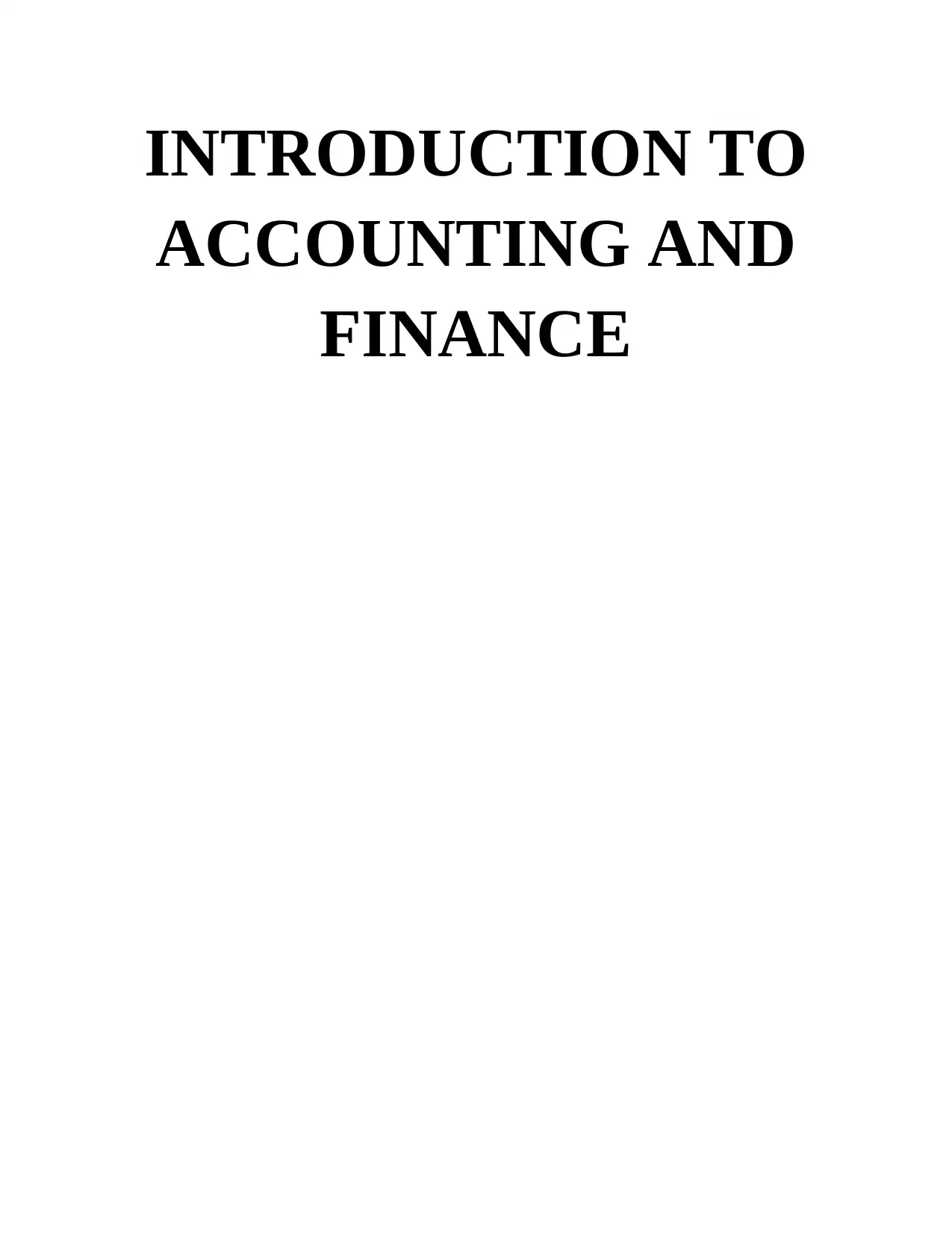
INTRODUCTION TO
ACCOUNTING AND
FINANCE
ACCOUNTING AND
FINANCE
Paraphrase This Document
Need a fresh take? Get an instant paraphrase of this document with our AI Paraphraser

Contents
INTRODUCTION.......................................................................................................................................3
MAIN BODY..............................................................................................................................................3
Part A – Terry Joe Plc..............................................................................................................................3
Statement of Income...............................................................................................................................3
Statement of Financial Position...............................................................................................................5
Part B – Kokolet Limited.........................................................................................................................6
(a) Contribution towards covering fixed costs...................................................................................6
(b) Break-even point and margin of safety..............................................................................................7
(c) Profit the company:............................................................................................................................8
(d) Marketing and advertising..................................................................................................................8
(e) Explain the underpinning assumptions attached to the break-even model.........................................9
Part C – Smith Howe Limited...................................................................................................................10
(a) Payback Period, Accounting Rate of Return and Net Present Value of the machine........................10
(b) Explains and analyses the key merits and limitations of the differing investment appraisal
techniques..............................................................................................................................................14
Key benefits and limitations of using various budgets for strategic planning........................................15
CONCLUSION.........................................................................................................................................17
REFERENCES..........................................................................................................................................18
INTRODUCTION.......................................................................................................................................3
MAIN BODY..............................................................................................................................................3
Part A – Terry Joe Plc..............................................................................................................................3
Statement of Income...............................................................................................................................3
Statement of Financial Position...............................................................................................................5
Part B – Kokolet Limited.........................................................................................................................6
(a) Contribution towards covering fixed costs...................................................................................6
(b) Break-even point and margin of safety..............................................................................................7
(c) Profit the company:............................................................................................................................8
(d) Marketing and advertising..................................................................................................................8
(e) Explain the underpinning assumptions attached to the break-even model.........................................9
Part C – Smith Howe Limited...................................................................................................................10
(a) Payback Period, Accounting Rate of Return and Net Present Value of the machine........................10
(b) Explains and analyses the key merits and limitations of the differing investment appraisal
techniques..............................................................................................................................................14
Key benefits and limitations of using various budgets for strategic planning........................................15
CONCLUSION.........................................................................................................................................17
REFERENCES..........................................................................................................................................18
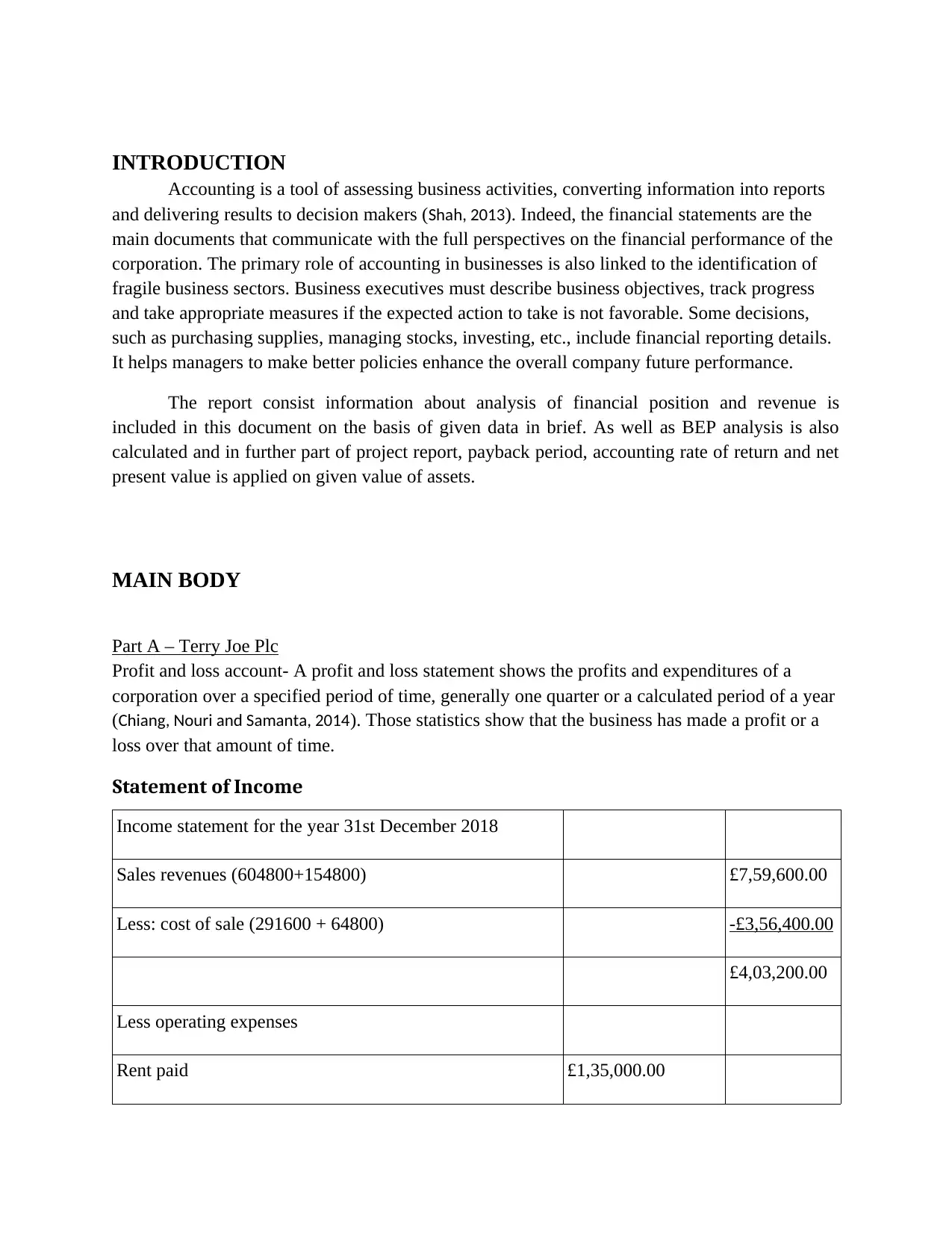
INTRODUCTION
Accounting is a tool of assessing business activities, converting information into reports
and delivering results to decision makers (Shah, 2013). Indeed, the financial statements are the
main documents that communicate with the full perspectives on the financial performance of the
corporation. The primary role of accounting in businesses is also linked to the identification of
fragile business sectors. Business executives must describe business objectives, track progress
and take appropriate measures if the expected action to take is not favorable. Some decisions,
such as purchasing supplies, managing stocks, investing, etc., include financial reporting details.
It helps managers to make better policies enhance the overall company future performance.
The report consist information about analysis of financial position and revenue is
included in this document on the basis of given data in brief. As well as BEP analysis is also
calculated and in further part of project report, payback period, accounting rate of return and net
present value is applied on given value of assets.
MAIN BODY
Part A – Terry Joe Plc
Profit and loss account- A profit and loss statement shows the profits and expenditures of a
corporation over a specified period of time, generally one quarter or a calculated period of a year
(Chiang, Nouri and Samanta, 2014). Those statistics show that the business has made a profit or a
loss over that amount of time.
Statement of Income
Income statement for the year 31st December 2018
Sales revenues (604800+154800) £7,59,600.00
Less: cost of sale (291600 + 64800) -£3,56,400.00
£4,03,200.00
Less operating expenses
Rent paid £1,35,000.00
Accounting is a tool of assessing business activities, converting information into reports
and delivering results to decision makers (Shah, 2013). Indeed, the financial statements are the
main documents that communicate with the full perspectives on the financial performance of the
corporation. The primary role of accounting in businesses is also linked to the identification of
fragile business sectors. Business executives must describe business objectives, track progress
and take appropriate measures if the expected action to take is not favorable. Some decisions,
such as purchasing supplies, managing stocks, investing, etc., include financial reporting details.
It helps managers to make better policies enhance the overall company future performance.
The report consist information about analysis of financial position and revenue is
included in this document on the basis of given data in brief. As well as BEP analysis is also
calculated and in further part of project report, payback period, accounting rate of return and net
present value is applied on given value of assets.
MAIN BODY
Part A – Terry Joe Plc
Profit and loss account- A profit and loss statement shows the profits and expenditures of a
corporation over a specified period of time, generally one quarter or a calculated period of a year
(Chiang, Nouri and Samanta, 2014). Those statistics show that the business has made a profit or a
loss over that amount of time.
Statement of Income
Income statement for the year 31st December 2018
Sales revenues (604800+154800) £7,59,600.00
Less: cost of sale (291600 + 64800) -£3,56,400.00
£4,03,200.00
Less operating expenses
Rent paid £1,35,000.00
⊘ This is a preview!⊘
Do you want full access?
Subscribe today to unlock all pages.

Trusted by 1+ million students worldwide
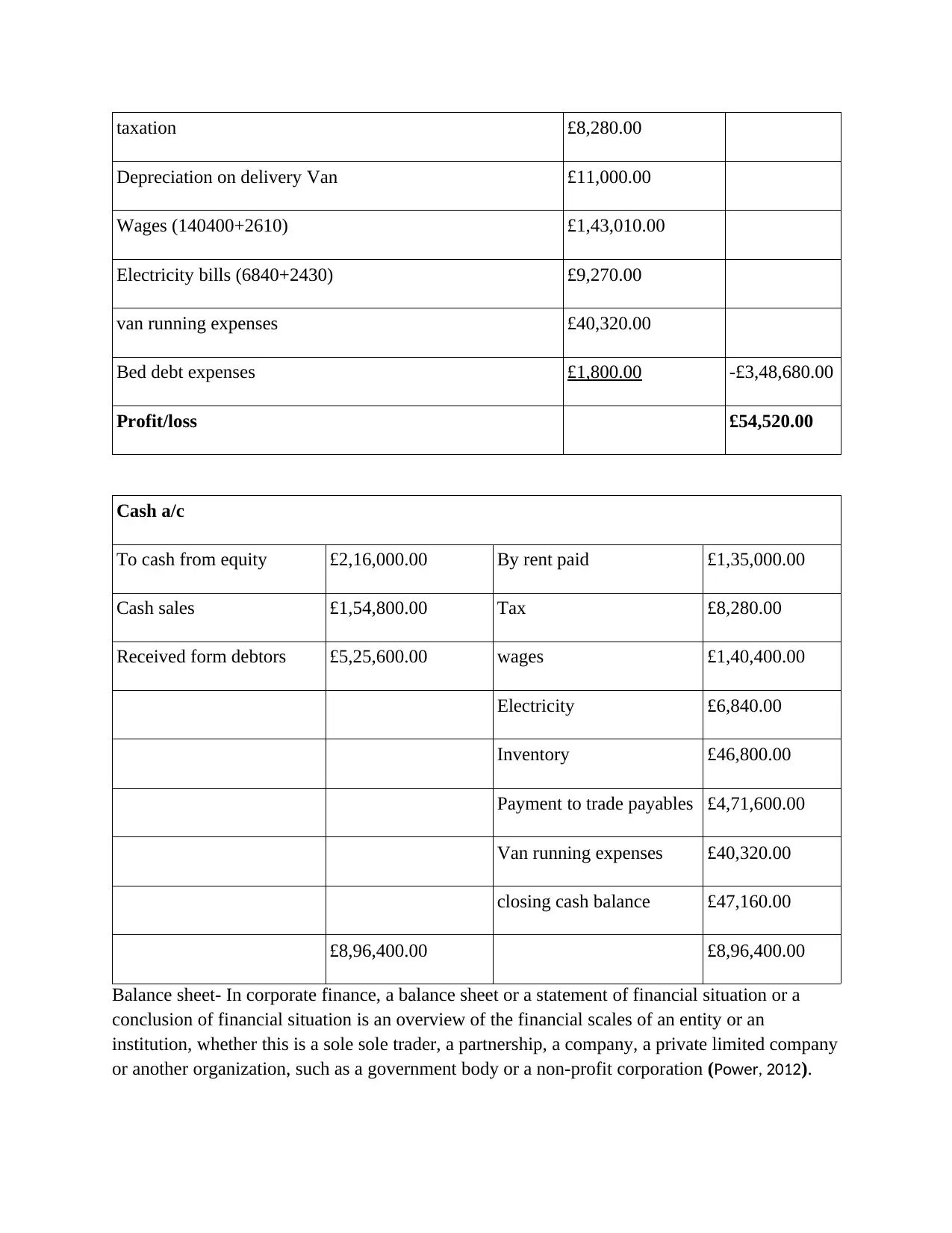
taxation £8,280.00
Depreciation on delivery Van £11,000.00
Wages (140400+2610) £1,43,010.00
Electricity bills (6840+2430) £9,270.00
van running expenses £40,320.00
Bed debt expenses £1,800.00 -£3,48,680.00
Profit/loss £54,520.00
Cash a/c
To cash from equity £2,16,000.00 By rent paid £1,35,000.00
Cash sales £1,54,800.00 Tax £8,280.00
Received form debtors £5,25,600.00 wages £1,40,400.00
Electricity £6,840.00
Inventory £46,800.00
Payment to trade payables £4,71,600.00
Van running expenses £40,320.00
closing cash balance £47,160.00
£8,96,400.00 £8,96,400.00
Balance sheet- In corporate finance, a balance sheet or a statement of financial situation or a
conclusion of financial situation is an overview of the financial scales of an entity or an
institution, whether this is a sole sole trader, a partnership, a company, a private limited company
or another organization, such as a government body or a non-profit corporation (Power, 2012).
Depreciation on delivery Van £11,000.00
Wages (140400+2610) £1,43,010.00
Electricity bills (6840+2430) £9,270.00
van running expenses £40,320.00
Bed debt expenses £1,800.00 -£3,48,680.00
Profit/loss £54,520.00
Cash a/c
To cash from equity £2,16,000.00 By rent paid £1,35,000.00
Cash sales £1,54,800.00 Tax £8,280.00
Received form debtors £5,25,600.00 wages £1,40,400.00
Electricity £6,840.00
Inventory £46,800.00
Payment to trade payables £4,71,600.00
Van running expenses £40,320.00
closing cash balance £47,160.00
£8,96,400.00 £8,96,400.00
Balance sheet- In corporate finance, a balance sheet or a statement of financial situation or a
conclusion of financial situation is an overview of the financial scales of an entity or an
institution, whether this is a sole sole trader, a partnership, a company, a private limited company
or another organization, such as a government body or a non-profit corporation (Power, 2012).
Paraphrase This Document
Need a fresh take? Get an instant paraphrase of this document with our AI Paraphraser
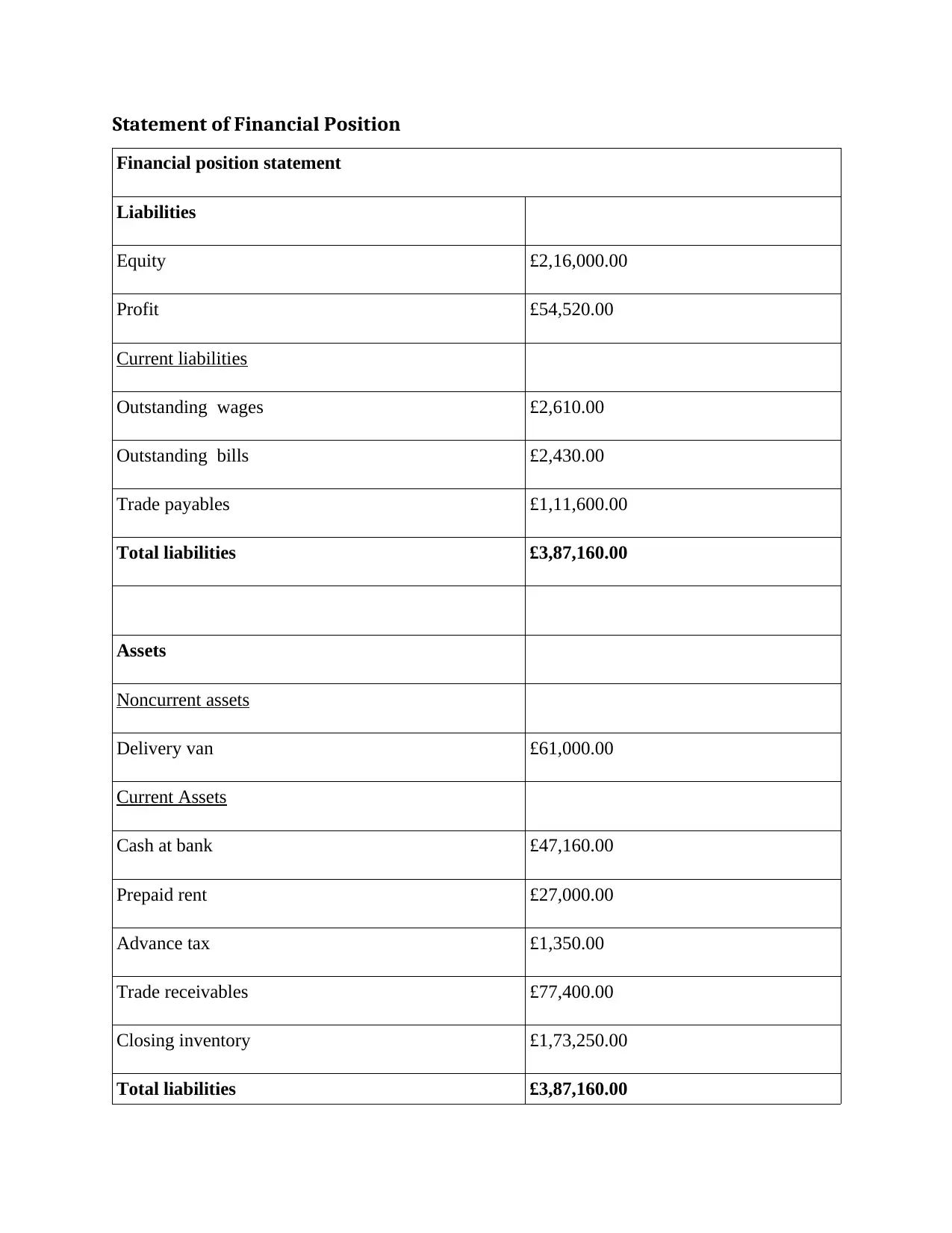
Statement of Financial Position
Financial position statement
Liabilities
Equity £2,16,000.00
Profit £54,520.00
Current liabilities
Outstanding wages £2,610.00
Outstanding bills £2,430.00
Trade payables £1,11,600.00
Total liabilities £3,87,160.00
Assets
Noncurrent assets
Delivery van £61,000.00
Current Assets
Cash at bank £47,160.00
Prepaid rent £27,000.00
Advance tax £1,350.00
Trade receivables £77,400.00
Closing inventory £1,73,250.00
Total liabilities £3,87,160.00
Financial position statement
Liabilities
Equity £2,16,000.00
Profit £54,520.00
Current liabilities
Outstanding wages £2,610.00
Outstanding bills £2,430.00
Trade payables £1,11,600.00
Total liabilities £3,87,160.00
Assets
Noncurrent assets
Delivery van £61,000.00
Current Assets
Cash at bank £47,160.00
Prepaid rent £27,000.00
Advance tax £1,350.00
Trade receivables £77,400.00
Closing inventory £1,73,250.00
Total liabilities £3,87,160.00

Part B – Kokolet Limited
(a) Contribution towards covering fixed costs
Contribution- Contribution is the amount of profit left after all total costs have been
deducted from income. Contribution must be computed on the premise of the
accumulation basis of bookkeeping, so that all revenue-related costs are acknowledged in
same timeframe as profits.
Selling price £40.00
Less: variable cost
Material £15.75
Labor £8.85
Variable overhead £5.55 -£30.15
Contribution per unit £9.85
Sales £24,00,000.00
Less: variable cost
Material £9,45,000.00
Labor £5,31,000.00
Variable overhead £3,33,000.00 -£18,09,000.00
Contribution per unit £5,91,000.00
(a) Contribution towards covering fixed costs
Contribution- Contribution is the amount of profit left after all total costs have been
deducted from income. Contribution must be computed on the premise of the
accumulation basis of bookkeeping, so that all revenue-related costs are acknowledged in
same timeframe as profits.
Selling price £40.00
Less: variable cost
Material £15.75
Labor £8.85
Variable overhead £5.55 -£30.15
Contribution per unit £9.85
Sales £24,00,000.00
Less: variable cost
Material £9,45,000.00
Labor £5,31,000.00
Variable overhead £3,33,000.00 -£18,09,000.00
Contribution per unit £5,91,000.00
⊘ This is a preview!⊘
Do you want full access?
Subscribe today to unlock all pages.

Trusted by 1+ million students worldwide
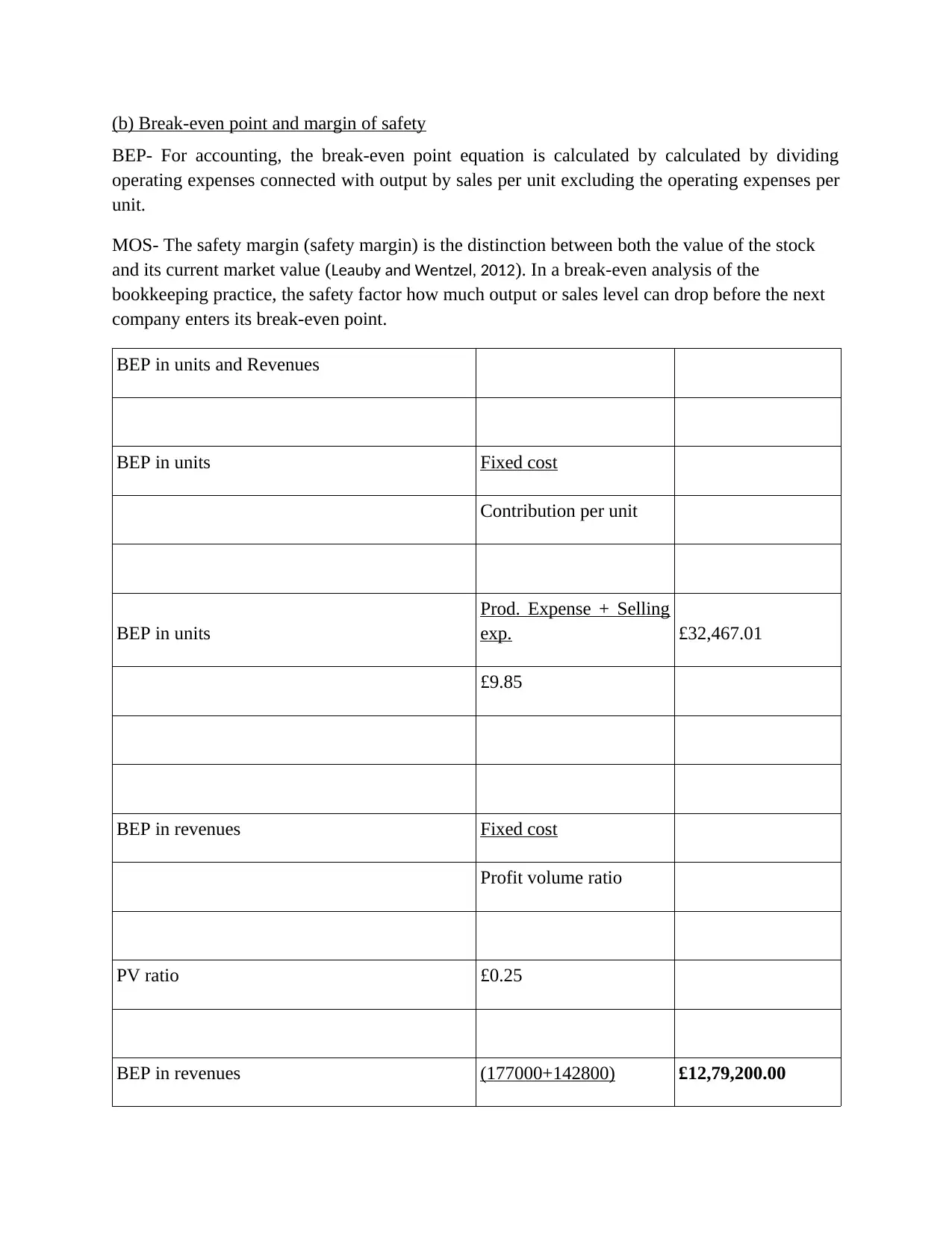
(b) Break-even point and margin of safety
BEP- For accounting, the break-even point equation is calculated by calculated by dividing
operating expenses connected with output by sales per unit excluding the operating expenses per
unit.
MOS- The safety margin (safety margin) is the distinction between both the value of the stock
and its current market value (Leauby and Wentzel, 2012). In a break-even analysis of the
bookkeeping practice, the safety factor how much output or sales level can drop before the next
company enters its break-even point.
BEP in units and Revenues
BEP in units Fixed cost
Contribution per unit
BEP in units
Prod. Expense + Selling
exp. £32,467.01
£9.85
BEP in revenues Fixed cost
Profit volume ratio
PV ratio £0.25
BEP in revenues (177000+142800) £12,79,200.00
BEP- For accounting, the break-even point equation is calculated by calculated by dividing
operating expenses connected with output by sales per unit excluding the operating expenses per
unit.
MOS- The safety margin (safety margin) is the distinction between both the value of the stock
and its current market value (Leauby and Wentzel, 2012). In a break-even analysis of the
bookkeeping practice, the safety factor how much output or sales level can drop before the next
company enters its break-even point.
BEP in units and Revenues
BEP in units Fixed cost
Contribution per unit
BEP in units
Prod. Expense + Selling
exp. £32,467.01
£9.85
BEP in revenues Fixed cost
Profit volume ratio
PV ratio £0.25
BEP in revenues (177000+142800) £12,79,200.00
Paraphrase This Document
Need a fresh take? Get an instant paraphrase of this document with our AI Paraphraser

£0.25
(c) Profit the company:
Profit calculation at 54000 units of sales
Sales £21,60,000.00
Less: variable cost
Material £8,50,500.00
Labor £4,77,900.00
Variable overhead £2,99,700.00 -£16,28,100.00
Contribution per unit £5,31,900.00
Less: Fixed expenses
Production expenses £1,77,000.00
Selling expenses £1,42,000.00 -£3,19,000.00
Profit/loss £2,12,900.00
(d) Marketing and advertising
Selling price @ (40+ (40*8%)) £43.20
Less: variable cost
Material £15.75
(c) Profit the company:
Profit calculation at 54000 units of sales
Sales £21,60,000.00
Less: variable cost
Material £8,50,500.00
Labor £4,77,900.00
Variable overhead £2,99,700.00 -£16,28,100.00
Contribution per unit £5,31,900.00
Less: Fixed expenses
Production expenses £1,77,000.00
Selling expenses £1,42,000.00 -£3,19,000.00
Profit/loss £2,12,900.00
(d) Marketing and advertising
Selling price @ (40+ (40*8%)) £43.20
Less: variable cost
Material £15.75
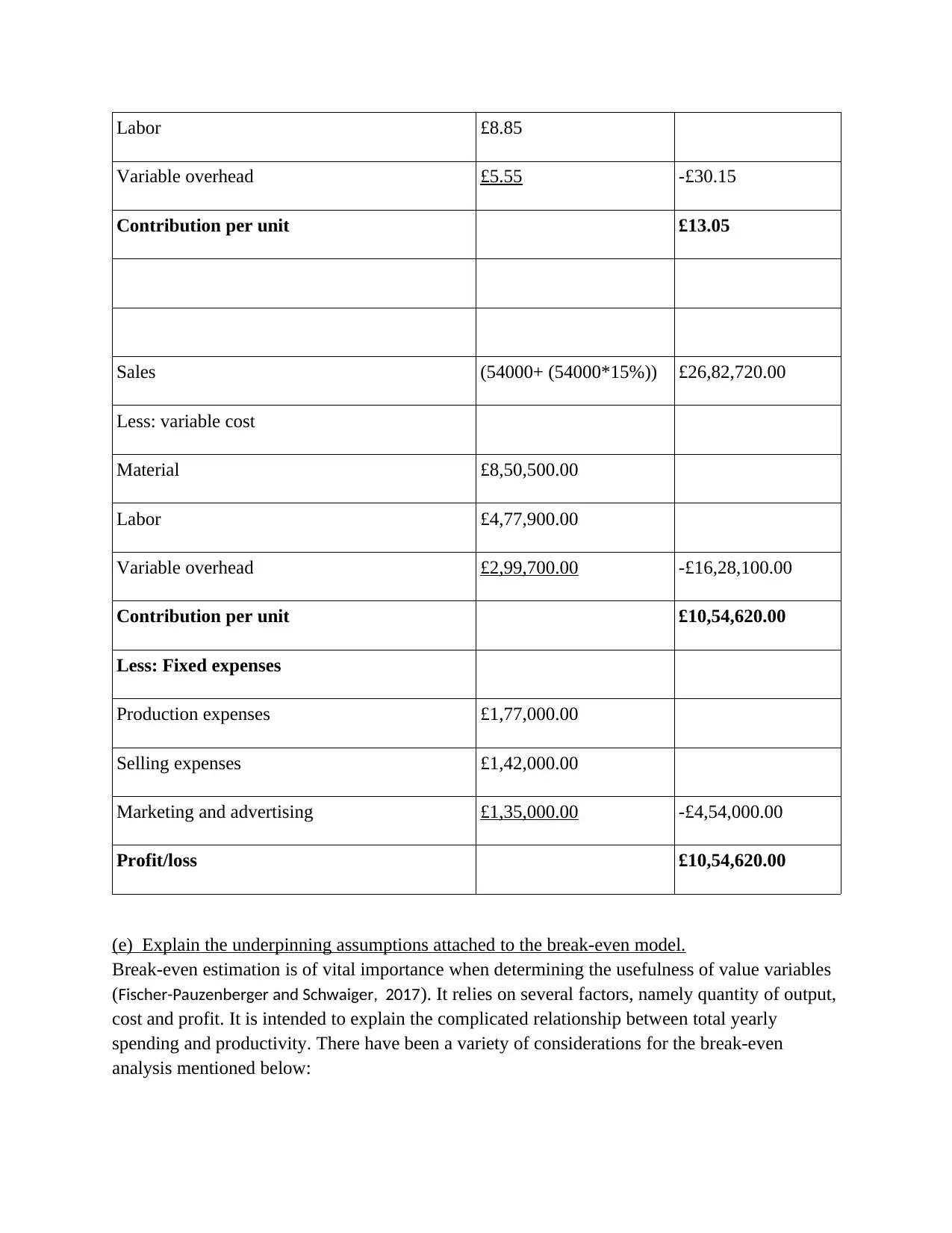
Labor £8.85
Variable overhead £5.55 -£30.15
Contribution per unit £13.05
Sales (54000+ (54000*15%)) £26,82,720.00
Less: variable cost
Material £8,50,500.00
Labor £4,77,900.00
Variable overhead £2,99,700.00 -£16,28,100.00
Contribution per unit £10,54,620.00
Less: Fixed expenses
Production expenses £1,77,000.00
Selling expenses £1,42,000.00
Marketing and advertising £1,35,000.00 -£4,54,000.00
Profit/loss £10,54,620.00
(e) Explain the underpinning assumptions attached to the break-even model.
Break-even estimation is of vital importance when determining the usefulness of value variables
(Fischer-Pauzenberger and Schwaiger, 2017). It relies on several factors, namely quantity of output,
cost and profit. It is intended to explain the complicated relationship between total yearly
spending and productivity. There have been a variety of considerations for the break-even
analysis mentioned below:
Variable overhead £5.55 -£30.15
Contribution per unit £13.05
Sales (54000+ (54000*15%)) £26,82,720.00
Less: variable cost
Material £8,50,500.00
Labor £4,77,900.00
Variable overhead £2,99,700.00 -£16,28,100.00
Contribution per unit £10,54,620.00
Less: Fixed expenses
Production expenses £1,77,000.00
Selling expenses £1,42,000.00
Marketing and advertising £1,35,000.00 -£4,54,000.00
Profit/loss £10,54,620.00
(e) Explain the underpinning assumptions attached to the break-even model.
Break-even estimation is of vital importance when determining the usefulness of value variables
(Fischer-Pauzenberger and Schwaiger, 2017). It relies on several factors, namely quantity of output,
cost and profit. It is intended to explain the complicated relationship between total yearly
spending and productivity. There have been a variety of considerations for the break-even
analysis mentioned below:
⊘ This is a preview!⊘
Do you want full access?
Subscribe today to unlock all pages.

Trusted by 1+ million students worldwide
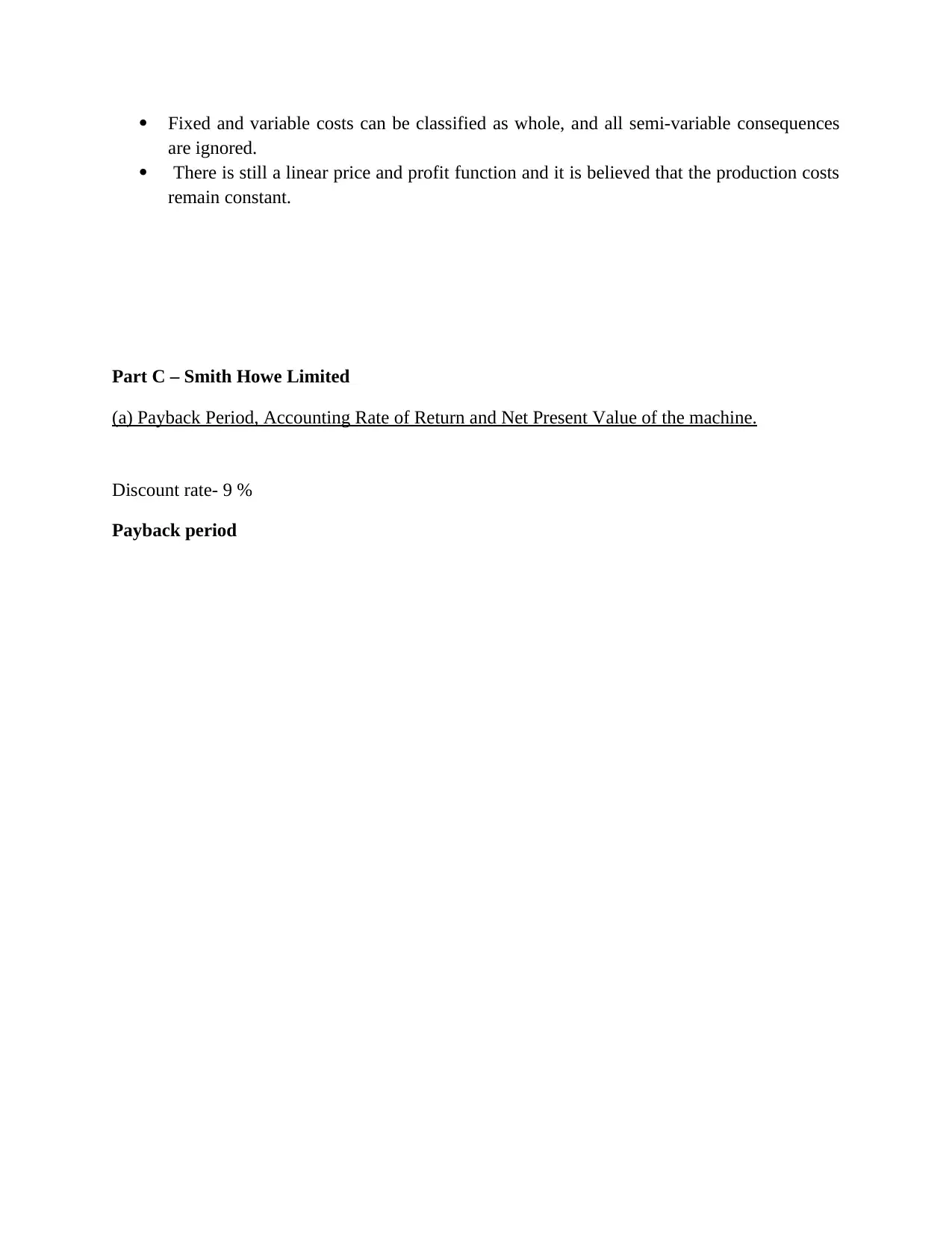
Fixed and variable costs can be classified as whole, and all semi-variable consequences
are ignored.
There is still a linear price and profit function and it is believed that the production costs
remain constant.
Part C – Smith Howe Limited
(a) Payback Period, Accounting Rate of Return and Net Present Value of the machine.
Discount rate- 9 %
Payback period
are ignored.
There is still a linear price and profit function and it is believed that the production costs
remain constant.
Part C – Smith Howe Limited
(a) Payback Period, Accounting Rate of Return and Net Present Value of the machine.
Discount rate- 9 %
Payback period
Paraphrase This Document
Need a fresh take? Get an instant paraphrase of this document with our AI Paraphraser


Undiscounted Payback Period Analysis
⊘ This is a preview!⊘
Do you want full access?
Subscribe today to unlock all pages.

Trusted by 1+ million students worldwide
1 out of 19
Related Documents
Your All-in-One AI-Powered Toolkit for Academic Success.
+13062052269
info@desklib.com
Available 24*7 on WhatsApp / Email
![[object Object]](/_next/static/media/star-bottom.7253800d.svg)
Unlock your academic potential
Copyright © 2020–2025 A2Z Services. All Rights Reserved. Developed and managed by ZUCOL.




